A Swedish company for sale
On a cold December evening in 1931, a young security officer named Erik patrolled the snowy streets of Odense in southern Denmark. With shoes soaked from the evening's heavy snow, he caught a glimpse of a family gathered around the fireplace in the warmth of their home. Surrounded by the quiet snowfall, Erik realized the profound duty he held as society's vigilant protector. This small but significant moment marked the beginning of Erik Philip-Sörensen's lifelong commitment and set the stage for a journey that would propel an entire industry forward.
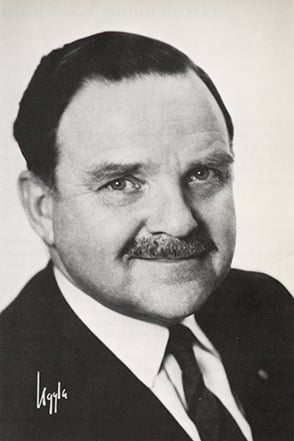
Portrait of Erik Philip-Sörensen
Born in 1909, Erik Philip-Sörensen is undeniably a pivotal figure in Securitas history, as it was his vision that brought the company into existence. Yet, to achieve such a dream requires more than just imagination. It demands relentless effort, innovative thinking, and a willingness to take risks. While the official birth of Securitas was on May 11, 1934, with the modest purchase of office supplies and a map, the origins of Securitas can be traced back even earlier.
As a young man, Erik first wanted to become an actor or a journalist, but his father, who owned a small security company, convinced him to have a proper business education. After graduating, Erik spent a few years as a clerk in a garment store and as a traveling salesman in Germany. In 1931, at the age of 22, he started working as a security officer in his father's security firm in Odense - the step that became his life’s calling.
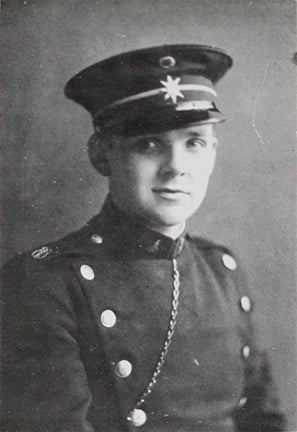
Photo from Erik Philip-Sörensen's days as a young security officer in Denmark
After a few years as a security officer, Erik got word that a guarding company was for sale in Helsingborg, Sweden. The owners were old, and the company was on the market for a bargain. Erik, accompanied by his father, took the ferry over the strait to Sweden to meet with the seller in Helsingborg. In the 1930s, Danish businesses were not particularly welcome in Sweden. Sadly, skepticism toward foreign managers of Swedish companies was prevalent until the 1960s. Luckily, the seller was open-minded and saw no obstacles for a Dane to establish himself in Sweden.
A Dane in Sweden
Erik traveled to Helsingborg to formally take ownership of Hälsingborgs Nattvakt (Hälsingborg's Night Watch), the company which would become Securitas. The official registration took place on May 11, 1934.
At the inaugural meeting of Hälsingborg's Night Watch, it was decided that Erik would take the role of CEO, earning a monthly salary of 250 kronor. Interestingly, the entire workforce – Erik and three officers – all received the same salary. He rented a small office in a building overlooking the port, bought a city map and spent his first days cycling the streets of Helsingborg, knocking on doors, inquiring if businesses needed guarding. The future looked bright!
As days passed, Erik realized he had been overconfident. The clients did not bite, and in a move to prevent the company from going bankrupt, all salaries were reduced to 220 kronor a month. Furthermore, murmurs about the suitability of Danes guarding Swedish sites started to float. The great depression was still hampering the economy, which raised questions about foreigners taking Swedish jobs. On top of that, Erik’s Swedish proficiency was not yet top-notch, which sometimes led to awkward situations. One time, he referred to a Consul General as a director, which was a major faux pas in a time when titles held considerable importance.
Despite a slow start, the young company’s first contract was signed on May 15. For the monthly rate of 9.44 kronor, Erik agreed to provide surveillance services for a large villa in Helsingborg owned by Åke G. Hedbrandh, the director of a local undergarment factory. More contracts followed, slowly but surely, and the company began building momentum.
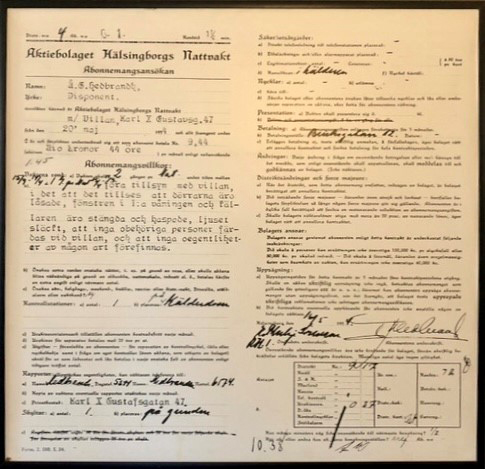
The first contract, still hanging in the Helsingborg office today
A sweet success
In 1935, during the first full year of Hälsingborg’s Night Watch operation, things started to turn for the better. With the successful first fiscal year as motivation, Erik wanted to expand. Coming back from Halmstad, North of Helsingborg, Erik’s father gave Erik a valuable tip: apparently, there was no competition in the city of Halmstad. Opening a security company there was a low-hanging fruit.
Taking his father's advice and thanks to excellent cooperation with the police, the venture was an immediate success. Two full-time security officers and one reserve were hired. Soon after the success of the Halmstad operation began, the office manager of Hälsingborg's Nattvakt was able to present to its board a portfolio with monthly earnings of 829.49 kronor.
Erik had become a seasoned salesman, and records show that in the last week of March 1935, he made more than 60 client visits. On one day alone, the records list 16 client visits. "May submit a quote”, "May return”, and "Must wait 14 days for a decision", the notes read.
During a particularly bleak period in 1935 when the company’s bank only held 6 kronor, Erik faced a critical moment that required nothing short of a miracle. Determined to turn the tide, he embarked on what he considered to be the most significant sales success of his career. Erik approached Sigurd Ekman, the CEO of a large sugar company. To his surprise, Erik secured a surveillance contract worth 600 kronor a month. From that client win, things started to look up, as he could tell other industries that the sugar company had accepted his firm's services. The sugar factory carried significant clout in southern Sweden, which led to two new major clients: a stocking factory and a textile mill.
At a company meeting on June 1, 1935, the name of the parent company was changed to Förenade Svenska Vakt (United Swedish Guard Corporation), a name it would retain for over 35 years until it became part of Securitas.
Smarter ways of working
The more clients Erik could serve within a concentrated area, the better and more cost-effective the guarding. Running a small-scale operation, Erik constantly needed to find ways to work smarter. Rationalization to improve officers’ working conditions was important, but Erik also needed to increase profits. Over time, the strategic problem of route and time became something that Erik spent a lot of time refining.
Another important invention was the key-pulling system. This system involved hanging keys at strategic locations within the client's premises, which the officer pulled through his patrol clock, thus recording the officers’ presence and time of visit. Originally, it was a German invention, but Erik extensively applied and improved it. At the beginning of the 20th century, guards had to carry heavy bags of keys, and losing them could risk unauthorized access to valuable assets. Thanks to the key-pulling system, the officers did not have to carry heavy keychains, and clients could rest assured that their premises were guarded.
![]()
Specialized security started with sugar
To manage the stocking factory and the textile mill, his two new major clients, Erik Philip-Sörensen wanted to increase the presence in the city of Malmö. In 1935, Erik sat across from Sergeant Major Jacobsson, negotiating the acquisition of Malmö Nattvakt (Malmö Night Watch). On the table between them lay Jacobsson's two guns, a silent statement of Jacobsson's negotiating style. The air was charged with tension. Despite Erik’s obvious discomfort, Jacobsson refused to put the guns away. At one point, the story goes, Jacobsson fired a shot into the wall, to demonstrate who had the upper hand.
Because of the unpredictable Jacobsson, the acquisition did not materialize. Erik had to wait until 1973 to acquire Malmö Nattvakt AB – allegedly without shots fired. To solve his pressing recruitment needs, Erik hired an officer tasked with cycling between the two locations, safeguarding their premises. This marked the beginning of what would become one of the largest divisions within Securitas and signaled the start of an era of rapid expansion.
The company now counted four sugar factories as clients. To be able to deliver valuable security, a new category of officers was introduced: specialized guards. In an early issue of the employee magazine Väktaren (The Officer), supervising officer and “sugar specialist” Gustav Steimer was celebrated for his exemplary performance in guarding the sugar factory in the tiny village of Arlöv.
The deployment of sugar specialists marked the first time in Securitas' history that specialized guards, trained to protect specific sites or sectors, were introduced. The ability to customize security services to the distinct needs of diverse industries is as relevant today. In early 2024, Securitas introduced a training of 10,000 guards to become certified data center security professionals, with the ability to manage data centers' diverse security challenges with efficiency and expertise.
Competition from small-scale companies
In the 1940s, small enterprises, often run by one or two officers, started to become serious competitors to the larger companies in the security industry. The 1940 Annual Report described the trend as “these companies have aggressively pursued our client base; however, our division has yet to directly confront this competitor, despite their offers to provide security services at half our rates."
Price dumping – significantly undercutting prices to gain market share – started to become increasingly common. The small companies’ strategy was not only to compete with lower prices; they also operated with the aim of being acquired by larger entities in the industry. Larger companies, such as Erik’s, tried to maintain the security industry's integrity and reputation by absorbing these smaller players, thereby preventing any potential harm to the industry through less reputable practices. Eventually, the small-scale companies started to pose a real threat, but Erik’s slim profit margins did not allow competing with these small-scale enterprises on price. Despite a considerable turnover growth in 1940, the surplus amounted to only 500 kronor per month.
Taking the west coast…
Years of nonstop work had worn Erik down. When his mother passed, Erik checked into a sanatorium to be able to rest. The timing was not perfect since negotiations to acquire the large security company Städernas Vakt (The Cities' Guard) had already begun. But Erik had a secret weapon. By his side, he had Karin Persson, his trusted secretary. While Erik was recharging his batteries, all negotiations were handled by her. Negotiations were complex, but thanks to Karin’s extraordinary capabilities, Förenade Svenska Vakt managed to acquire Städernas Vakt in 1959, and the foundation was laid for what would eventually become Securitas.
Back in full swing later that year, Erik fulfilled a long-held ambition by purchasing Gothenburg’s leading security firm, Göteborgs Nattvakt och Garanti (Gothenburg's Night Watch and Guarantee Corporation), which was promptly rebranded as West Swedish Guard. It would still take a few more years to acquire the next major competitor, further solidifying Securitas' foundation.
… and the east coast
Herman Zetterberg was Sweden's Minister of Justice between 1945 and 1957. Through marriage, Herman owned the company Svensk Nattvakt (Swedish Night Guard), which was the dominant security company in Stockholm. With that company in the group, Erik would reach a nationally strong market position. Therefore, Erik initiated negotiations to buy the company, but it was far too expensive. He turned to a group of insurance companies for financial help, and because of Erik’s good reputation, he was able to borrow 4 million kronor. He deposited the money in his own account.
"Everything looks good," Herman said when the negotiations were over. "Now, show me the money”. To Hermans’ surprise, Erik took out his checkbook and wrote a check for four million. Herman gave the accompanying banker a surprised look. The banker nodded in assurance, and Herman took out his notebook and wrote "four million received as payment...". Erik had to gently remind Herman to give him the shares.
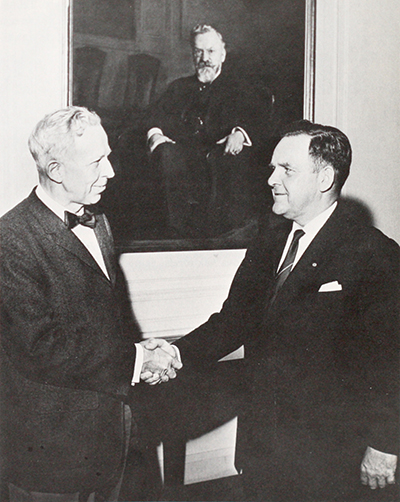
Herman Zetterberg and Erik Philip-Sörensen shake hands on what was then the largest security services acquisition in Swedish history
In the early years, acquisitions were a significant part of the growth strategy, and it has persisted throughout history. For 90 years, acquisitions have helped Securitas expand its market, create synergies, and gain access to talent. As recent as at the Capital Market Day in March 2024, CFO Andreas Lindback highlighted that acquisitions remain a crucial part of Securitas’ future strategy today.
![]()
A code of conduct for officers
A cold spring day in May 1955 the first ever Officers’ Day took place in Malmö, Sweden. The ceremony began with the mayor of Malmö lighting three candles by the altar in S:t Petri Church. One candle each for Honesty, Vigilance, and Helpfulness. When the ceremony was over, the officers, guided by a marching band, walked over to the movie theater Alcazar, where the movie The Officer was to be premiered.
Innovative ways of increasing officers’ self-esteem and solidarity were something Securitas’ founder, Erik Philip-Sörensen, prioritized. The Officers' Day was an appreciated initiative that helped to create team spirit. It would be followed by the much larger Officers’ Assemblies, the first of which was held in Brunnsvik, Sweden, in 1958.
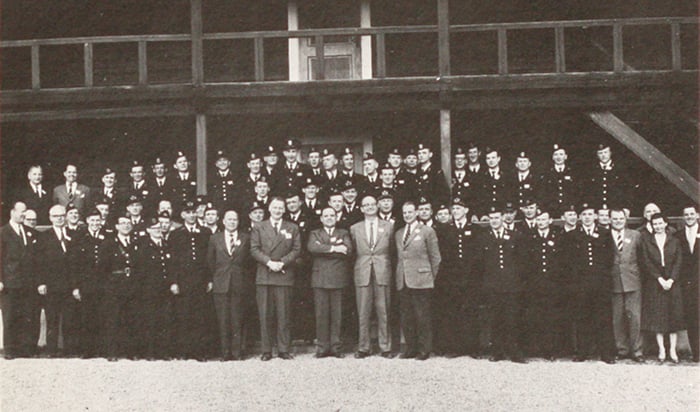
Brunnsvik, May 6, 1958. Erik Philip-Sörensen flanked by Securitas biographer Sten Söderberg and Diocesan Assistant Nils-Hugo Ahlstedt
Ethical standards on paper
In early 1958, a group of officers approached Erik requesting that something was done to protect the profession and ensure its integrity. The reason for the concern was an incident where an officer did not live up to his trust and responsibility and eventually ended up in prison.
Securitas survived the setback, and the client, although not happy, understood that human error can occur. But for the officers, the incident was a disaster. They needed assurance that something similar did not happen again. Erik shared the officers' concern and acted swiftly. He consulted Nils-Hugo Ahlstedt, nicknamed the "industrial priest”, who served as an advisor on ethical practices and had helped other growing companies in Sweden develop ethical frameworks.
In May 1958, 53 officers gathered in Brunnsvik, in the middle of Sweden, to develop a code of conduct for officers. After a couple of intense working days together with the industrial priest, the first code of conduct for officers, comprising twenty items, was drafted and signed by the officers present. The code of conduct, along with Erik’s personal commentary, was then published as a book. The twenty items were also printed on a small, laminated card that officers could keep in a wallet or pocket. Key items included:
- Officers are under a duty of confidentiality to protect themselves, the security company, and the client.
- The officer corps is a uniformed corps, where everyone is responsible for everyone – criticism of a single officer's behavior reflects on all officers.
- Officers uphold the honor of the corps. The high demands and great responsibility are their professional pride.
- Officers consider any appropriation as theft.
- The duty to report is uncompromising.
- An officer must not become dependent on those he/she is overseeing.
- Corrections must not be derogatory or offensive to the wrongdoer.
Taking one step further
To Erik, it was of utmost importance that the discussions about the code of conduct did not end with establishing the twenty items in the book. He stressed the importance of continuing the work with the norms, recognizing it as an activity that is never finished. Erik also wanted to transfer as much responsibility as possible to the officers themselves. He also came up with an idea of how to make that happen: the Officer Assembly.
Two years after the meeting in Brunnsvik, the first Officer Assembly with elected representatives was held. Erik liked to refer to the assembly as the Officers' Parliament, and he suggested the formation of an "Officers’ National Council." The assembly elected ten officers to lead the initiative. The elected officers received special training as, for example, discussion facilitators at a fourteen-day stay in Mallorca, Spain.
Courage and a sense of humor
Sixteen years after the Code of Conduct for Officers was published, Erik was asked in an interview what the most important quality of a good officer is. He answered that a good officer always lives by the values of Integrity, Vigilance, and Helpfulness. At the end of the interview, Erik revealed what the most important qualities, thereafter, are: courage and a sense of humor.
By the end of the 1970s, a total of ten Officers' Meetings were held every two years. In his 1966 Christmas and New Year greeting in the employee magazine Väktaren (The Officer), Erik wrote: "The fourth Officers' Assembly in Rättvik was held in May and the norm movement has really grown strong within the Securitas companies, as evidenced by the record interest in the Officers' Assemblies. For me personally, the development of the norm movement is a source of the greatest joy."
To live and work according to values and purpose has had a profound positive impact on clients and the world at large. Leaders who embody Securitas' timeless values have shaped the culture and maintained a commitment to excellence, from 1934 to present day. Adding also a focus on continuous improvement and innovation, Securitas will be able to address the evolving needs of our clients and the broader security landscape.
The photograph of the first contract is private. All other photographs are from the book Vakt av värde by Sten Söderberg (1979). Photographers unknown. If you own the rights, please contact
press@securitas.com.







